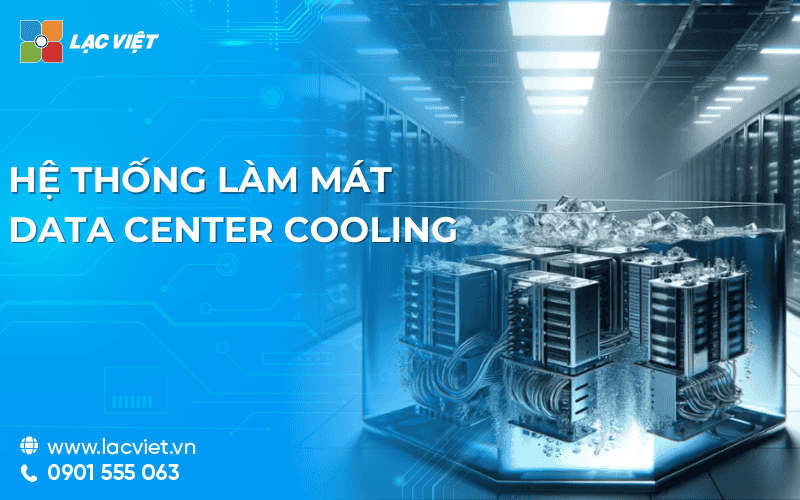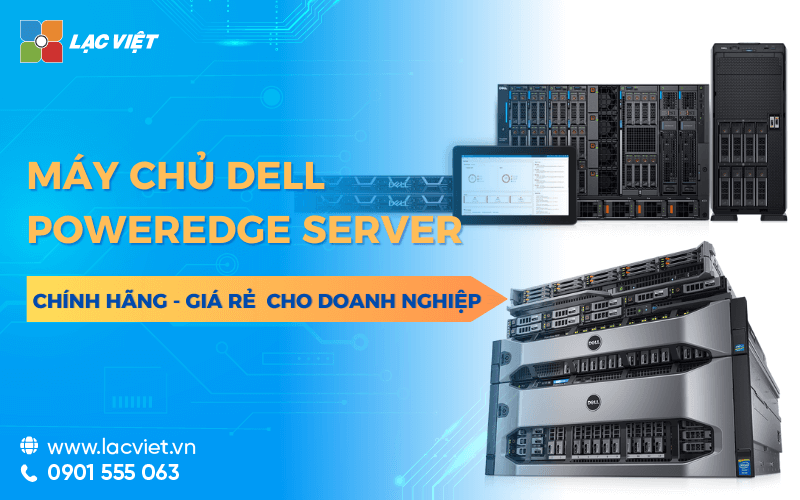Data center (data center) is the “heart” of the business activities, where to store and handle the data volume is huge. However, the operation of the servers (server) in the data center birth to a large amount of heat, if not controlled effectively, which can lead to damage, decreased performance, even service interruption. Therefore, the cooling system center data data center cooling become the vital factor to help ensure stable operation, sustainability of the business.
This article Lac Viet Computing will provide detailed insight about the concept, the role of the cooling system center data, which helps businesses choose the most suitable solution for his needs.
1. Data Center Cooling is what?
Data Center Cooling is the system technology and equipment is designed to maintain temperature, humidity, air flow stability in the data center, ensure sustainable operation of the server, related equipment. This solution is mandatory for all data centers, from small scale to large systems enterprise level.
The cooling system occupies 30-50% of the total energy cost of data centers. The application of cooling solutions, modern not only reduce energy costs but also to help businesses achieve the goals of sustainable development.
The standard temperature – humidity are recommended (according to ASHRAE)
- Temperature: Organization ASHRAE recommended temperature ideal for the data center is located in the range 18-27°C.
- Humidity: the humidity Level optimal ranges from 40-60%, avoiding the phenomenon of static electricity buildup and corrosion components.
- Air flow: Ensure the speed, direction of air flow evenly to avoid hot spots (hot spots).
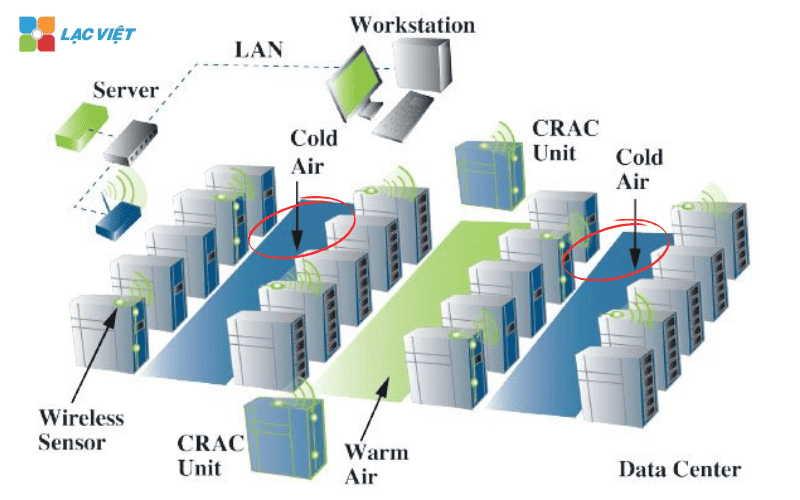
2. The importance of the cooling system in the data center
The impact of high temperature on the performance, longevity of the server
- Reduced performance: the server is too temperature will automatically reduce the processor speed to protect the system, affect the work productivity of the entire data center.
- Increased risk of downtime: statistics from Gartner showed that 80% of the fixed network infrastructure, derived from the temperature does not control.
- Increase in cost of maintenance and replacement components: high Temperature forcing companies to spend more to maintenance, replacement of equipment failure.
Cooling system center data not only helps to maintain the optimum temperature for the equipment, but also ensure the safety and performance of the server. When the temperature exceeds the threshold, the components such as CPU, hard drive, motherboard risk failure, causing serious damage in terms of cost, duration.
According to a study from the Uptime Institute, ambient temperature increase of 10°C may reduce the life expectancy of the servers up to 50%. Therefore, the cooling efficiency is not only a technical solution but also as a strategy to save long term costs for the business.
3. The method of cooling the Data center cooling downloads
When selecting the cooling system for data center (data center), businesses need to understand the common method today to ensure optimum efficiency, meet the technical requirements. Below is the cooling method popular with the advantages and disadvantages to business considerations.
3.1. Air-cooled (Air-based Cooling)
Principle of operation: air-cooled operation is based on the circulation flow cold air to reduce the temperature in the data center. Air flow is adjustable, distributed through the cooling equipment, creating the ideal environment for the device operation.
The equipment typically used
- CRAC (Computer Room Air Conditioner): air conditioning, dedicated, helps maintain temperature and humidity stable.
- CRAH (Computer Room Air Handler): Manage the flow of air through the heat exchanger, in accordance with the big data center.
Benefits
- Easy to deploy: air cooled is the traditional method, in accordance with most data centers.
- Low investment costs: Especially suitable for the small and medium business.
- Easy maintenance: Equipment, air-cooled, has a long lifespan, maintenance costs are not too high.
Restrictions
- Performance limitations: Difficult to maintain stable temperature when the thermal load increases.
- Consume energy: Need large energy consumption to cool the entire space data center, which leads to high operating costs.
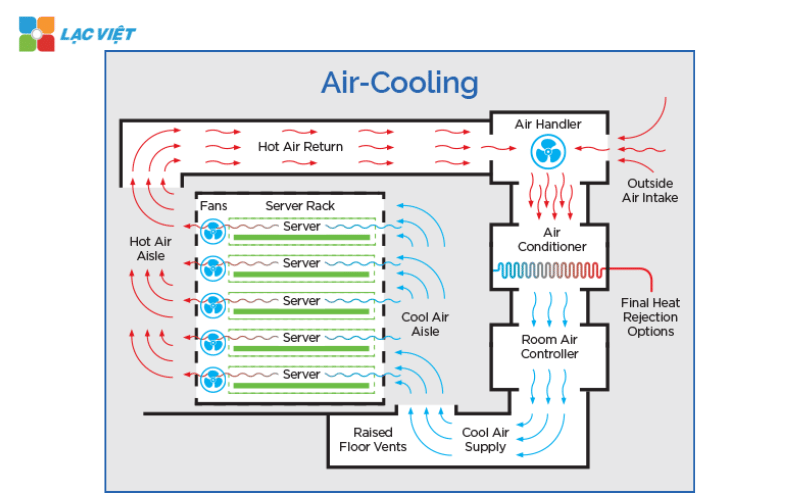
3.2. Liquid-cooled (Liquid-based Cooling)
Principle of operation: the System liquid-cooled, use water or a special solution to absorption and heat conduction out of the server. This is the solution there are cooling performance superior to air.
The solution, liquid-cooled,
- Immersion Cooling: The device is soaked in a solution of insulation capable of high thermal conductivity, which helps reduce direct heat, quickly.
- Direct-to-chip Cooling: coolant is led directly to the CPU chip or GPU through the pipes, enhancing the cooling effect.
Benefits
- High performance: with liquid cooling can reduce the temperature quickly, even in the data center density high gear.
- Save space: compact System, in accordance with the data center has limited space.
- Energy saving: Requires less energy than air-cooled.
Restrictions
- High investment costs: Systems, liquid-cooled, require the special equipment, the installation process of the complex.
- Maintenance complex: ask the technical expertise to operate and maintain the system.
- The risk of a leak: even Though the risk is low, the fluid leaks can cause damage to the device.
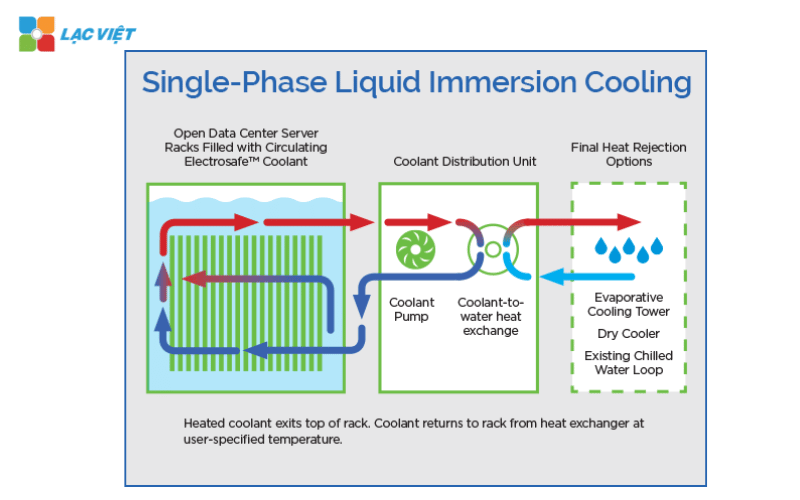
3.3 cooling server data center with water (Data Center Water Cooling)
Principle of operation of the Water Cooling: System cooled using liquid, mainly water, to absorb the heat generated from the device server. Heat is then led through the heat pipe to the heat exchangers or cooling towers, where water is cooled before returning to the cycle cooling. The water is led directly to the department radiate heat as big as CPU or GPU through the heat pipe for professional use.
Benefits of technology Water Cooling
- Cooling performance superior: available Water capacity high thermal conductivity 4 times the air, helps reduce the heat quickly even in environmental heat load is high. Reduce the risk of the formation of “hot spots” (hot spots) in the data center, ensure the server stable operation.
- Energy saving: the System water-cooled consume less energy than air-cooled, especially when combined with the energy saving technologies such as Free Cooling. Index of PUE (Power Usage Effectiveness) of the data center using Water Cooling often reaching levels below 1.2, compared with an average 1.6-1.8 of the other methods.
- Noise reduction and space required: Not required system fan big power such as air-cooled, which helps to minimize noise. System Water Cooling more compact, which saves space for the data center area is limited.
- Environment-friendly: Reduce CO2 emissions by using energy more efficiently. When combined with water reuse or water from the natural environment, this technology increases sustainability.
When business should consider Water Cooling?
- When data center density servers high: water-cooled is the optimal choice to solve the problem of the heat load is high.
- When needed, energy saving, long: Though the cost of the initial investment, but Water Cooling brings long-term benefits of operating costs.
- When priority environmental sustainability: businesses want to reduce emissions, energy use efficiency should consider this technology.
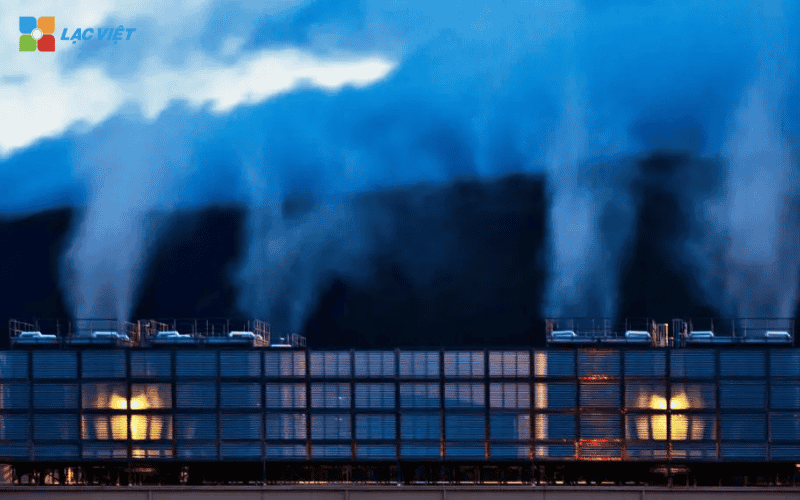
3.4. Cooling system Hybrid Cooling Systems
Cooling system hybrid (Hybrid Cooling Systems) is the combination of two technologies, the primary cooling is air cooling (Air Cooling), cooling liquid (Liquid Cooling).
How it works:
- The air-cooled responsible for reducing the overall temperature in the room air through the air conditioning system, air cooling fan.
- The cooled liquid is used to heat treatment at the point of radiating heat, such as chip CPU and GPU. Water or coolant is led directly to the this position to absorb the heat.
Advantages
- High performance: With the coordination of both technologies, the system has the ability to handle the heat load is very large, even in the data center density servers high. Minimizes “hot spots” (hot spots) in the server rack.
- Flexible: can be customized for every scale, from data centres, small to large systems. The ability to integrate advanced technologies such as AI to automatically adjust the air flow and liquid according to the actual demand.
- Save long-term costs: cool futuristic take advantage of the performance of liquid-cooled, which does not require invest fully into the system liquid-cooled (usually the initial cost is very high). Save more energy than cooling only air in the large data center.
Restrictions
- The initial cost is high: The installation of the cooling system, it requires greater investment than traditional cooling system by air.
- Complex in design and implementation: high technical requirements to coordinate the two systems operate efficiently. Maintenance process more complex due to handling all air system, liquid.
3.5. Cooling technology advanced
Cooling technology is the integration of artificial intelligence (AI) to analyze and manage the temperature data in real time. WHO help monitor and adjust cooling system based on factors such as heat load, air flow, operation of the server.
WHO in the management of temperature: Cooling technology is the integration of artificial intelligence (AI) to analyze, manage, temperature data in real time. WHO help monitor and adjust cooling system based on factors such as heat load, air flow, operation of the server.
Outstanding advantages
- Automation: AI predicts the potential hotspots and automatically adjust the airflow or liquid flow to prevent incidents.
- Energy saving: WHO optimize the energy usage, reduce the consumption of which still ensure efficient cooling.
- Decision support: Based on the data collected, WHO gave the hint system improvements to enterprise upgrade or adjust more suitable.
Technology, Free Cooling: Free Cooling is a cooling technology take advantage of air or cold water from the natural environment, particularly effective in areas with cold climate, or temperate.
How it works
- Cold air from the environment outside is filtered and leads directly into the data center for cooling.
- In some cases, Free Cooling uses cold water from natural sources such as rivers and lakes or water recycling to reduce the heat.
Outstanding advantages
- Reduce energy costs: Up to 40% on energy costs compared with the method of cooling, traditional, thanks to take advantage of low temperature from the environment. Limit the use of air-conditioning equipment, air, help save power.
- Environment-friendly: in accordance with the trend of sustainable development, minimize CO2 emissions. Take advantage of renewable energy such as wind or natural water.
- High performance in areas of cold climate: Free Cooling maximum effectiveness in areas such as Northern Europe, North America, or the high mountain regions have low temperatures all year round.
Challenge
- Limit climate: Free Cooling does not fit in the tropical area or where there are high temperatures year-round.
- Installation cost: The deployment of Free Cooling requires special design, large investment initially.

4. Standard requirements for Data Center Cooling
The design of the cooling system is not merely control solution temperature, but also to meet the rigorous standards of energy efficiency, safety equipment and sustainability. Here are the specific requirements, standard business need to consider.
4.1. Energy efficiency indicator PUE
Energy efficiency is a core element of the design of the cooling system by system, this is usually accounted for 30-50% of the total energy consumption of the data center. A cooling system optimal't only help save operating costs, but also reduce the environmental impact.
Index of PUE (Power Usage Effectiveness) is the indicator to measure efficiency of energy use of data centers, calculated by total energy consumption of the entire center divided by the energy consumption of IT equipment.
Indicator PUE ideal is 1.0, that means the entire energy used for IT equipment, don't waste into the cooling system, or lighting. The data center is the like of Google and Facebook has reached a PUE average under 1.2, thanks to the advanced cooling.
4.2. Protect the safety and life expectancy of equipment
Cooling system not only need to ensure the temperature, stable humidity, but also must be designed for maximum protection equipment, maintain their lifespan.
- Ensure stable temperature: the ideal Temperature for servers usually within the range of 18-27°C, according to the recommendations of ASHRAE. Temperature exceeds this level will reduce performance, increase the risk of damage. The system should be equipped with temperature sensor precise to monitor and adjust timely.
- Reduce the risk of hardware failure: The hot spots (hot spots) in the data center can cause hardware failure, leading to the cost of major repairs, and interruption of the operation. Cooling locally (local cooling) or cooling directly (direct cooling) is the effective solution to handle the area to radiate heat.
- Backup system-safe: The data center should be equipped with cooling system redundancy (redundant cooling systems) to ensure continuous operation even when the system encountered a problem. Design the room usually consists of equipment CRAC/CRAH redundancy, cooling towers or water source reserve.
4.3. Sustainability and environmentally friendly
With the trend of globalization, businesses increasingly interested in the construction of the data center sustainability and minimize environmental impact.
Reduced CO2 emissions thanks to the technology advanced cooling
- Free Cooling: Use air source natural cold to help reduce energy consumption and CO2 emissions.
- Immersion Cooling: Up to 40% cooling energy compared with traditional methods, helps to reduce carbon footprint (carbon footprint).
The choice of materials and equipment, energy-saving
- Effective thermal insulation: material Use high-quality thermal insulation to reduce heat loss and energy consumption.
- Equipment with low energy consumption: the Selection of equipment, standard, energy saving, such as Energy Star or EPEAT.
Integrated renewable energy
- Many data center as big as Microsoft and Google have integrated sources of renewable energy such as solar, wind to provide energy for the cooling system.
- This is a significant step towards building the data center carbon neutral (carbon-neutral data centers).
5. Benefits of Data Center Cooling efficiency
System Data Center Cooling not only ensure the stable operation for the equipment, but also bring significant benefits in terms of performance, cost and reliability. Here are the outstanding benefits that a cooling system efficiency can bring to a business.
5.1. Increase the performance of servers
- Accelerate data processing: server operates in the environment of temperature help to maintain optimal performance, high processing, even when the work load spike. This is especially important for businesses that handle large amounts of data, such as banking, commerce, and technology.
- Prevents overheating (overheating): A cooling system, effectively remove the phenomena from excessive heat, helping to avoid status automatically reduce the performance (thermal throttling) to protect the device.
- Protect the components sensitive: The devices such as CPU, GPU, and hard drive is operated in terms of temperature stability, reducing the risk of failure, prolong the service life.
5.2. Save operating costs long-term
- Reduced energy consumption: The cooling technology modern as with liquid cooling (liquid cooling) or Free Cooling helps to reduce energy costs significantly, especially at the data center scale.
- Limit the cost of maintenance and replacement: the Temperature is well controlled to help reduce the frequency of breakdowns of equipment, thereby saving the cost of repairs and replacement components.
- Save space area: cooling solutions such as advanced liquid-cooled, save more space, to help businesses optimize area for other devices.
5.3. Ensure compliance with the international standards on data center
- Standard temperature and humidity of ASHRAE: A cooling system, effectively ensure compliance with the international standards such as ASHRAE TC 9.9, help businesses achieve the certification, global quality.
- Indicator PUE ideal: Business can improve indicator PUE (Power Usage Effectiveness), from which enhance credibility in the industry, attract more clients or investors interested in sustainability.
- Scalable, flexible: The cooling system standard allows businesses to easily upgrade and expand the data center when demand is high.
5.4. Enhance reliability and reduce downtimes
- Reduce the risks of damage and interruptions of the service: the Temperature is maintained stable help minimize the risk of the server being decommissioned, guaranteed uptime of almost absolute (99.999%).
- Increase the reliability of the system: A cooling system is good design not only protects your device, but also ensure the entire data center operation in a reliable way in a long time.
6. Selection guide system, data center cooling, suitable for business
Choose a data center cooling suitable not only help businesses protect the device but also optimize operating costs, enhance operational efficiency. Here are detailed instructions from determining the scale to deploy efficient cooling system.
Step 1. Determine the scale data center
Before choosing a cooling system, businesses need to clearly define the scale and characteristics of the data center to ensure the solution fits the actual needs.
- Data center small (Edge Data Center): Commonly used for small businesses or branch companies. Cooling solution downloads: air cooling (Air Cooling) with devices such as CRAC or the cooling system integrated compact.
- Data center, medium and large: Requires cooling system dedicated to handle the heat load is high. Cooling solution downloads: cooling System liquid (Liquid Cooling) or cooling system hybrid (Hybrid Cooling Systems).
- Data center high-density (High-Density Data Center): Require cooling solution as advanced as Immersion Cooling or Direct-to-Chip Cooling, matching the technology business, banking, or research institutions.
Depending on the scale data centers to select the cooling system is suitable
Step 2. Choice of cooling technology based on the operating requirements and budget
Depending on the operating requirements and budget, businesses can weigh between the cooling technology popular:
- Air cooling (Air Cooling): low investment Cost, easy to deploy, suitable with small and medium enterprises. However, performance is not high for data center, high-density, large energy consumption.
- With liquid cooling (Liquid Cooling): high performance, suitable for the data center load requirements heat. The cost of the initial investment, high maintenance requirements, complex.
- Cooling system hybrid (Hybrid Cooling): combines the advantages of air-cooled and liquid, suitable for any scale data centers. Higher cost air-cooled design, deployment more complex.
- Free Cooling: leveraging natural resources, reduce energy costs. In accordance with the area cold climate, is not feasible in places with high temperature.
Step 3. Design cooling system
Design details include air flow, fluid flow, position the cooling equipment.
Airflow (Airflow Design):
- Stream of hot air and cold: Need to design the area stream of hot air (hot aisle) and the flow of cold air (cold aisle), clear to optimize the cooling.
- Air convection: Ensure cold air is provided in the right direction to the device may heat load is high, avoid the phenomenon of “hot spots” (hot spots).
Fluid flow (Liquid Flow Rate):
- Flow calculation: Determine the flow of water or liquid is needed to absorb heat from the server, ensure effective without causing pressure excessive pressure to the pump or pipes.
- Materials pipes: Use corrosion resistant materials and heat resistant to increase durability of the system.
Position the cooling device:
- CRAC/CRAH Units: Place these devices near the area to radiate heat to reduce the distance air circulation, save energy.
- Heat exchanger (Heat Exchanger): design of heat exchangers in a convenient location for easy inspection and maintenance.
Step 4. System deployment
Deploy the cooling system requires close collaboration between the design team, technicians, equipment suppliers, to ensure the system works properly as expected.
System installation by design:
- Correct installation equipment: Ensure the device as CRAC, CRAH, or system, liquid-cooled, are put in place was designed. Check wiring led tube, led liquid sensor, to ensure that does not happen leakage or wrong connection.
- Check before commissioning: conducted test load test (load test) with the cooling equipment to ensure the ability to heat treatment in the conditions of actual operation. Measure temperature, humidity, air flow to confirm the parameters of standard design.
Technology integrated smart monitoring:
- AI and Machine Learning: Integration of AI to temperature monitoring, real-time detection and timely alert the hot spot or incident. Machine Learning learn from historical data to predict cooling needs and optimize energy consumption.
- IoT and smart sensors: sensors, IoT collect data from every area in the data center, team management, remote control, flexible adjustment. IoT system also helps to detect incidents in ducts or fan cooling, minimizes the risk of downtime.
Step 5. Inspection and maintenance
The inspection, periodic maintenance is crucial to maintain the performance of the cooling system.
Periodically check the system performance
- Temperature and humidity: periodically Check to ensure the temperature and humidity is always within the safety threshold (according to the standard ASHRAE). Particularly noted areas are device density or often radiate heat.
- Air flow and a liquid: Verify gas flow and liquid to ensure the cooling equipment is operating with optimum performance. Check out the bottlenecks in the system fans or ducts in order to avoid a decrease in performance.
Scheduled maintenance
- The cooling system by air: clean air filter to ensure the air circulation stability. Maintenance fan and equipment CRAC/CRAH to avoid wear and tear or damage.
- Cooling system fluid: Check the ducts to detect, handle leaks promptly. Replace or clean the fluid periodically to prevent clogging and increase the efficiency of heat transfer.
Updates and system upgrade
- Upgrade management software: Update the software, AI or IoT to take advantage of the new features, improve the efficiency of monitoring, optimization.
- Hardware upgrades: When data center expansion, enterprises need to upgrade the cooling equipment to meet the load demand higher heat.
7. These factors need to consider while choosing cooling systems servers
- Ambient temperature: data centers located in areas with high year-round temperatures need cooling system active, such as, liquid-cooled, or cooled future. In areas with cold climate, businesses can take advantage of Free Cooling to reduce costs.
- Deployment costs: Enterprises need to determine the budget of the initial investment and the comparison between the technology. For example, the cooled air has a lower cost but high energy consumption than liquid-cooled.
- Maintenance cost: The system such as, liquid-cooled, require maintenance more complicated, need calculate the cost long term. Cooling system air usually have low maintenance costs even more.
- Device density: data center density device need cooling solution as advanced as Immersion Cooling or Direct-to-Chip Cooling. Central low density can choose from air-cooled to cost savings.
- Scalability: Businesses should choose the cooling system has the ability to expand when scale data center growth in the future.
The selection and deployment of a system Data Center Cooling efficiency is an important step to ensure stable operation, long for the data center of the enterprise. Understood, implemented cooling system suitable not only help protect data and devices but also bring long-term benefits in terms of cost, performance. If your business is looking cooling solution for optimal, this is the time to invest in a system for Data Center Cooling, modern sustainable.

